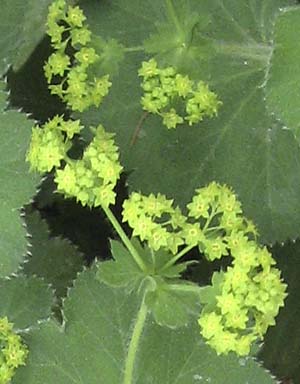A really lovely perennial semi evergreen plant to grace the garden. It is a perfect plant for those shady areas of the garden. It can be used as a ground cover or as a fill in with other shade loving plants. It's beautiful leaves and lovely chartreuse green flowers brighten any area. It does prefer a richer soil but will grow on poorer soils also. It does not need too much water but is not totally drought tolerant. Deer don't seem to eat it, neither do rabbits. Hardy to zone 4. Grow in groups for the best effect of the tiny flowers.
Description.
The leaves are rounded in outline with a finely toothed scalloped edge and noticeable ribs or veins. The rounded shape resembles a cape which is where the plant got it's name. The leaves are unusual in that they hold water so after rain or morning dew the leaves hold glittering liquid jewels. This water was once considered the purest of water and collected for use in cosmetics and chemical experiments.
The flowers arise in late spring to early summer (May - June in zone 6). Long stems rise above the leaves holding masses of tiny chartreuse colored flowers in what look like airy clouds. The flowers will brighten any shady area and the color is especially good as a companion to almost any other color. The flowers last a long time sometimes even adding extra blooms later in the year. The flowers then dry on the stem but keep their form and color sometimes for a couple of extra months making it appear to be in bloom much longer than it actually is.
Care and Placement.
In zones 6 and higher the plant needs shade. It grows very well under deciduous trees and will even grow in fairly deep shade. It does not grow well under coniferous trees (nothing much does.) It cannot easily tolerate full sun in lower latitudes and even in zone 6 the leaves will brown and curl up if given only a few hours of full sun per day. In higher zone 4-5 more sun might easily be tolerated.
It will grow very well on the north side of buildings which don't receive any direct light making it an excellent plant for an area where many other plants don't like to grow.
It prefers a richer soil with a reasonable amount of organic matter mixed in to grow really well. If under deciduous trees the falling leaves will provide much of the organic material it requires but for really strong plants adding a little more or blowing some leaves from the lawn into the bed in the fall will help a lot. It can grow in poorer soil I have a row growing on fairly poor sandy loam and doing fine but I suspect it would do better with more compost added.
Lady’s mantle will tolerate less water but is not drought tolerant. In times of low rainfall it will need some extra water to ensure it's survival. The summer drought of 2010 killed a lot of our plants that inadvertently did not get watered.
Most of the year it will have green leaves on it. If the temperatures drop very low these may die back but new green leaves arise from the root clump in the springtime. Don't cut back any dead leaves until the new leaves are up and fully formed as they help protect the new leaves during growth.
Once clumps are established they will spread slowly by rhizomes. If using as a ground cover make sure you have enough plants as it will not fill gaps quickly. Although the plant is not fully evergreen the leaf clumps do a fairly good job of suppressing the weeds most if not all of the year.
Great for use in cottage gardens, along shady pathways or rock gardens. The flowers are lovely and delicate and can bring a light airy feeling to any garden.
Growing.
Growing from seed is easy. Best started indoors where seed can take 3-4 weeks to germinate. Prick out seedlings when large enough to handle and grow to suitable size before planting out in a shady spot. Larger clumps can be divided in spring.
Uses.
The flowers make an excellent dried flower filler for any arrangement or bouquet. The small airy flowers fill in gaps they resist shattering and are very hardy. The flowers keep their color well and last for many years.
Edibility.
The young leaves are edible both raw and cooked. They have a somewhat astringent flavor. Dried leaves are also used as a tea for which they are used commercially.
Medicinal Uses
Lady’s mantle has a long history of herbal use. The plant is rich in tannins and so is an effective astringent commonly used both internally and externally in the treatment of wounds. It is also used for the treatment of diarrhea and a number of women's ailments, especially menstrual problems. Both the leaves and the roots are used though the roots are considered stronger. The freshly pressed leaf juice is used to heal skin problems such as acne and a decoction of the plant has been used in the treatment of conjunctivitis.









